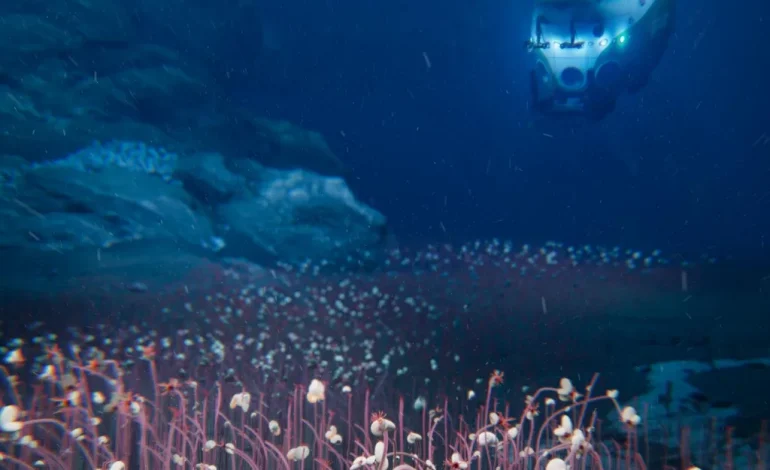In the pitch-black depths of the Pacific Ocean — where sunlight never reaches and pressure could crush a submarine — scientists have discovered something extraordinary: bustling colonies of sea creatures thriving over 30,000 feet beneath the surface.
Using a crewed submersible named Fendouzhe, researchers from the Chinese Academy of Sciences dove into the Kuril-Kamchatka and Aleutian trenches between Russia and Alaska. What they found floored them: dense communities of tube worms, clams, shrimp-like critters, and mollusks thriving in complete darkness — and under conditions once thought too extreme to support complex life.
Until now, scientists knew that tiny microbes survived in these deep ocean trenches — but sightings of bigger marine animals were rare. That changed when researchers witnessed vast fields of tube worms, some stretching up to 30 centimeters tall, along with unusual white, spiky creatures squirming among them.
“It was amazing,” said Dr. Mengran Du, one of the expedition’s leaders. “We didn’t expect to see such a variety of life — and in such abundance.”
Most life on Earth relies on sunlight and photosynthesis. But in these “hadal zones” — named after Hades, the Greek god of the underworld — it’s chemicals, not sunlight, that keep the party going.
Here, gases like methane and hydrogen sulfide leak through cracks in the ocean floor. Microbes feast on these chemicals and convert them into energy — a process known as chemosynthesis. Larger creatures like tube worms and mollusks either eat those microbes or live in symbiosis with them, absorbing the chemical-rich byproducts.
Think of it like a dark, underwater version of farming — without the sun.
This isn’t just about some weird worms and glow-in-the-dark bacteria. The discovery challenges long-standing ideas about where and how life can exist, especially in the harshest environments. And it could have implications far beyond Earth.
“If organisms can survive here,” said one biologist, “they might survive in deep oceans on icy moons like Europa.”
Over the course of 19 dives across 2,500 kilometers of trench, the team kept spotting signs of life — suggesting that these ecosystems aren’t isolated flukes but part of a much wider web of deep-sea biodiversity.
“These aren’t rare one-off discoveries,” said marine biologist Julie Huber. “These ecosystems could be all over the world’s trenches — we’ve just never looked closely enough before.”
While the trenches in this study are too deep for current deep-sea mining operations, the growing interest in harvesting ocean minerals for batteries and tech is raising alarms. Scientists warn that we still know far too little about these ecosystems — and could destroy them before we understand how they work.
“This discovery reminds us of how much we don’t know about our own planet,” said co-author Dr. Dominic Papineau. “And how careful we need to be when exploring or exploiting these environments.”
The team suspects many of the species they observed could be completely new to science. They’re now analyzing collected samples and plan to publish more findings in the months ahead.
They’re also curious about how these animals survive such crushing pressure and extreme conditions.
“There must be some biological trick,” said Dr. Du. “That’s the next mystery to solve.”
ABC News, Nature, BBC, and the Washington Post contributed to this report.










The latest news in your social feeds
Subscribe to our social media platforms to stay tuned